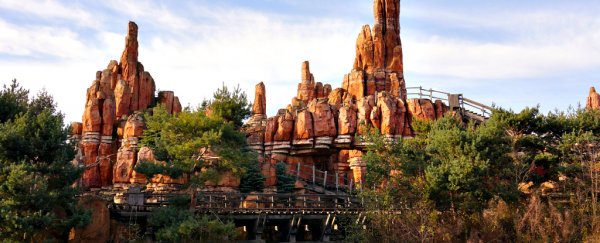One of Disney World's most iconic rollercoasters can help people pass their kidney stones less painfully, a new study suggests.
Researchers first noticed the trend when several of their patients reported passing kidney stones after going on Big Thunder Mountain Railroad at Disney World in Florida.
"Basically, I had patients telling me that after riding a particular roller coaster at Walt Disney World, they were able to pass their kidney stone," said lead researcher David Wartinger from Michigan State University.
He even had one patient tell him he had passed three different stones after riding on the roller coaster multiple times - a bizarre enough association for the Wartinger to team up with Washington doctor Marc Mitchell to investigate further.
Publishing their results in the Journal of the American Osteopathic Association, the team used an artificial kidney and a range of kidney stones to show that the roller coaster really does seem to help them pass more easily - if you sit in the right seat, that is.
Kidney stones are solid crystals that grow in your kidney when your urine contains high levels of certain chemicals, such as calcium or uric acid, that can't be diluted.
They can range in size from a grain of sand to a golf ball, and can be pretty agonising to pass. That's because the only way to get rid of them without medical intervention is for those kidney stones to travel down the ureter, to the bladder, and eventually get peed out.
Needless to say, ouch.
 remik44992/Shutterstock.com
remik44992/Shutterstock.com
But Thunder Mountain Railroad seems to somehow dislodge kidney stones and help them exit with less resistance.
To test this hypothesis, Mitchell and Wartinger developed a 3D model of a kidney that they could hide away in a backpack and take for a day out at Disney World.
Inside the artificial kidney, they placed three real kidney stones and some urine - the kidney stones were either small (4.5 cubic millimetres), medium (13.5 cubic millimetres), or large (64.6 cubic millimetres).
They then took the kidney on the roller coaster 20 separate times, putting one of the kidney stones in a different part of the kidney each time.
As Sara G. Miller explains for LiveScience:
"On one ride, for example, the largest stone was placed in the upper part of the kidney; on another, the large stone was placed in the middle of the kidney. Ultimately, each stone was placed in each location of the kidney for at least one ride."
At the end of the experiment, they found that there was one variable they couldn't control. "Seat assignment on the roller coaster was random and determined as a function of place in the waiting line," the team writes in their paper.
Because of that, they ended up sitting in a variety of spots in the roller coaster, which seemed to make a big difference when it came to whether a stone passed or not.
When the doctors sat in the rear car of the rollercoaster, the stones passed around 64 percent of the time. But when they sat in the front car, they only passed roughly 17 percent of the time.
That's strange enough, but the doctors then conducted an expanded study, where they took even more kidney stones on other roller coasters at the theme park. The results have yet to be published, but they suggest that something pretty special is happening on Big Thunder Mountain.
"In all, we used 174 kidney stones of varying shapes, sizes, and weights to see if each model worked on the same ride and on two other roller coasters," said Wartinger. "Big Thunder Mountain was the only one that worked. We tried Space Mountain and Aerosmith's Rock 'n' Roller Coaster and both failed."
He suggests that the problem with those two other rides is that they're too fast, with too much G-force, which pins the kidney and doesn't loosen up the stone.
"The ideal coaster is rough and quick with some twists and turns, but no upside down or inverted movements," said Wartinger.
Don't go booking your flights to Disney World just yet though, because a lot more research needs to be done to confirm these findings, and the hypothesis also needs to be tested in clinical trials using real patients.
But it's an interesting study worth following up on - especially if beneficial features of the roller coaster can be combined with existing kidney stone treatments.
And in the meantime, Wartinger says it's a relatively easy and safe (not to mention fun) thing for patients to try out - as long as they follow the health warnings on the roller coaster.
"Preliminary study findings support the anecdotal evidence that a ride on a moderate-intensity roller coaster could benefit some patients with small kidney stones," he said.
"If you have a kidney stone, but are otherwise healthy and meet the requirements of the ride, patients should try it. It's definitely a lower-cost alternative to health care."
